What Is Free Slack in Project Management? (With Examples)
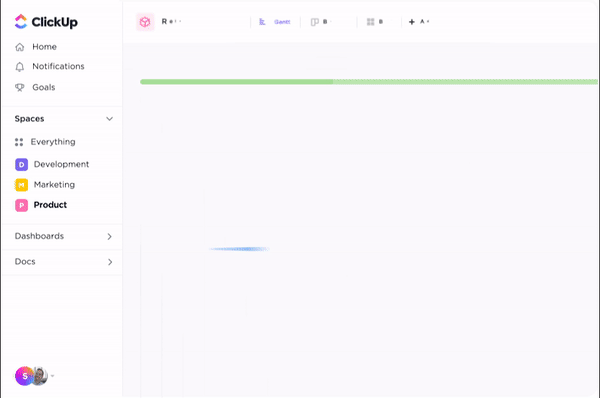
Sorry, there were no results found for “”
Sorry, there were no results found for “”
Sorry, there were no results found for “”

You’ve visualized your project on a Gantt chart. All dependencies are mapped out; the critical path identified.
Then one task gets delayed, and your entire project looks misaligned.
This is where free slack comes to your rescue. It shows how long you can delay a task before it affects the next one.
In dependency-heavy projects, where one blocked task can delay five more, free slack is a critical layer of structural risk control. It helps project managers move with confidence, not just by planning for ideal scenarios, but by designing schedules that can withstand the imperfect ones.
In this guide, we share everything you need to know about free slack in project management, with examples. We’ll also show you how to do it all efficiently with ClickUp.
Free slack, also known as ‘free float,’ is a key concept in project management that refers to the amount of time a task can be delayed without impacting any of its immediate successor tasks.
Here are some things to remember:
🔍 Did You Know? The concept of float, including free float, emerged with the development of the Critical Path Method (CPM) in the late 1950s and early 1960s to address complex project scheduling needs in the construction and defence industries.
📖 Also Read: Free Critical Path Templates
Projects rarely go exactly as planned. Free slack gives you a way to stay ahead.
Here’s how it helps you maintain your sanity and prevent the catastrophes that could derail the project.
📖 Also Read: Top Project Management Methodologies (+ Examples)
💡 Pro Tip: PERT charts (Program Evaluation Review Technique) help you map out task dependencies and estimate timelines using optimistic, pessimistic, and most likely durations. Once you visualize paths and time estimates, it’s easier to identify where slack exists, even before locking down final dates.
Free slack is especially useful when you’re working with scheduling tools using the critical path method or any software that handles task dependencies.
Here’s how you can calculate free slack, step by step.
Say you’re managing a product development timeline. It involves these tasks in a project schedule:
Here’s all you need to do:
So the EF of Task A = Day 1 + 9 days; hence, EF = 10
And the earliest start of the successor tasks is Day 12, so ES = 12
💡 Pro Tip: When a task has more than one immediate successor, it can be unclear which one to reference for calculating free slack. Always use the earliest start date among all successor tasks in your free slack calculation. This ensures you’re accounting for the most time-sensitive dependency and not creating a hidden bottleneck in your schedule.
Here’s the formula for free slack in float project management:
Free Slack = Earliest Start of successor tasks – Early Finish of current task
If the result is 0, then the task is critical. Any delay here affects what comes next.
And if the number is a positive number, there’s your free slack. You can delay the task by that many days without pushing the next one.
📌 Example: Continuing the previous product development example, here’s how it’ll go:
Even if the finish date for Task A shifts from Day 10 to Day 12, the timeline for Task B remains untouched, because you’re still within the 2-day free slack window.
We’ve illustrated this example with a Gantt chart that lays out the tasks on a timeline, showing start and end dates, dependencies, and slack time. It’s a great way to spot free slack at a glance.
Notice the visible gap between the end of Task A and the start of Task B? This is your free slack.
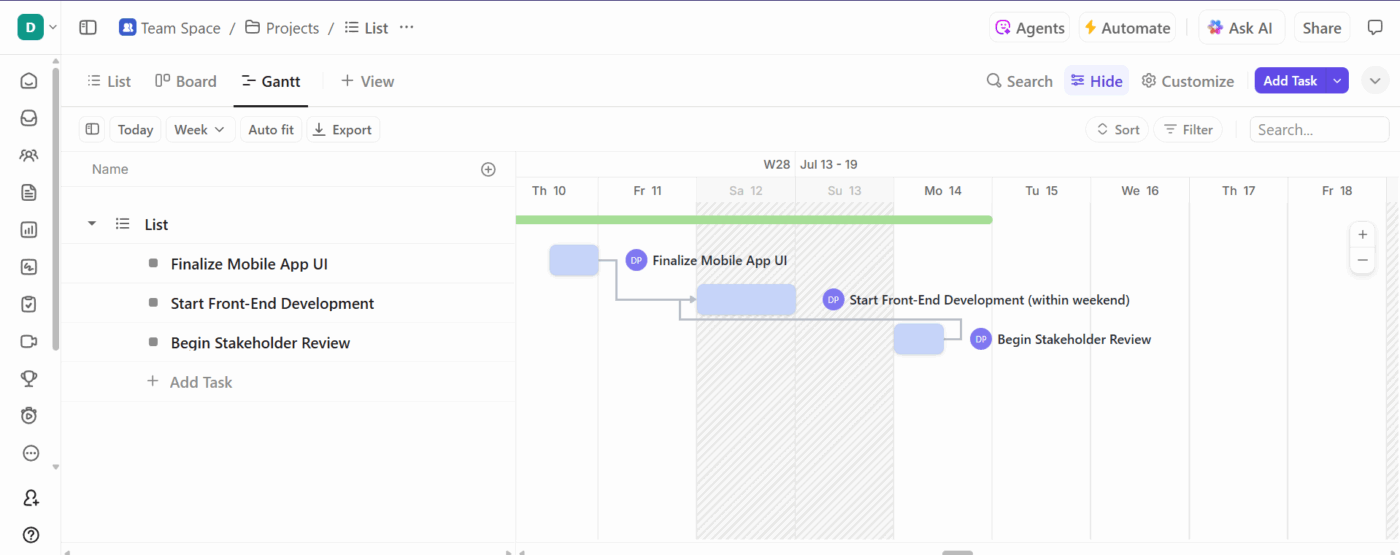
💡 Pro Tip: If you’re using a project management tool like ClickUp, calculating free slack becomes much easier through the ClickUp Gantt Chart View.
It lays out your entire project on a horizontal timeline, showing how tasks connect and where there’s room to breathe. The diamond icon indicates Gantt chart milestones like a launch date, approval point, or phase completion.
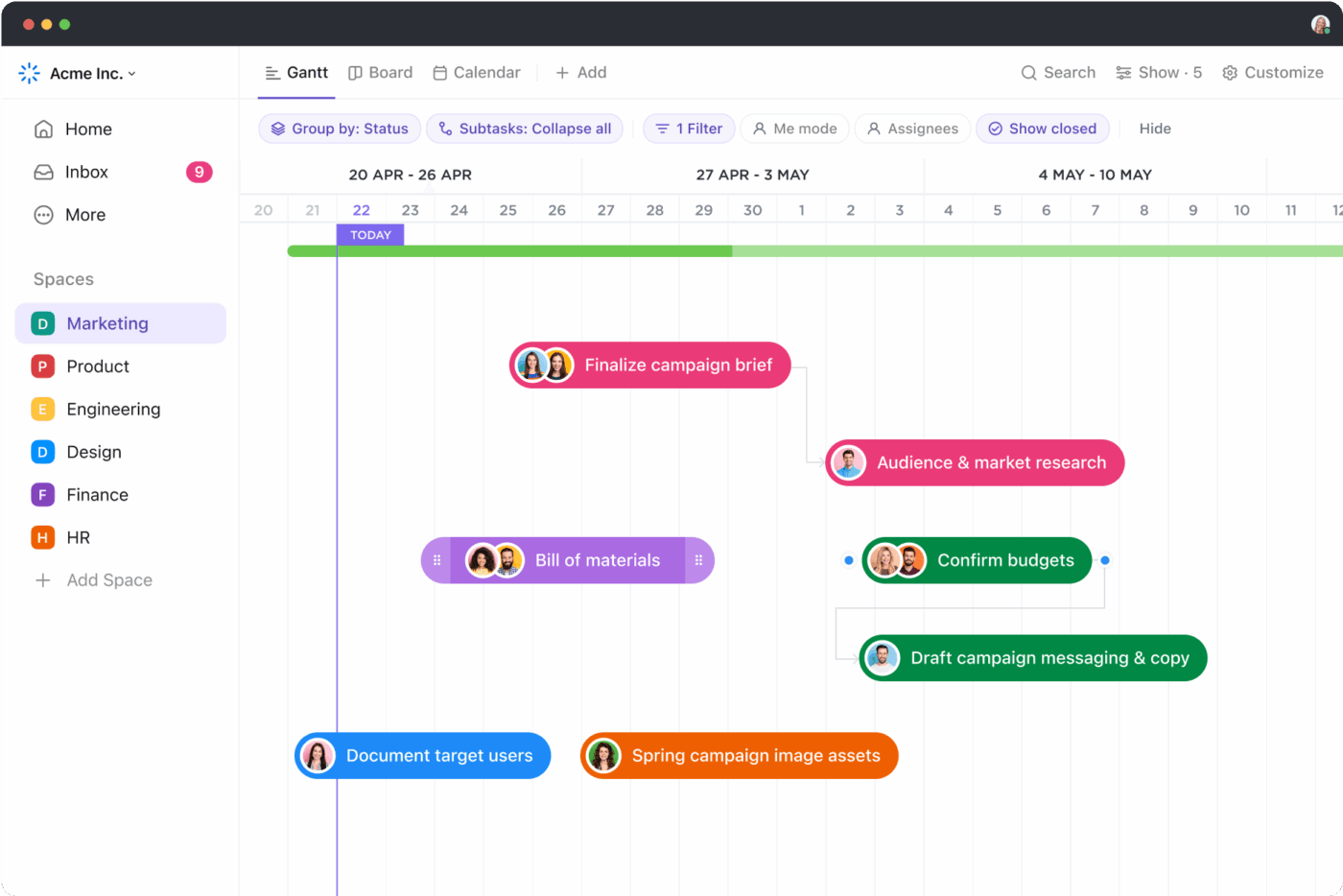
When deadlines shift, you can simply move the task bars. The project scheduling software automatically updates connected tasks, preserving your dependency logic and instantly showing changes in a task’s total slack.
Slack is the ‘critical path’ (pun intended!) to understanding where you have flexibility in project scheduling. Another term you’ll come across is total slack or total float.
Total slack indicates the overall flexibility of the project, while free slack provides the day-to-day wiggle room necessary for smooth execution and effective management of individual tasks and resources.
Here’s a quick comparison to explain the difference between free and total slack in project management.
| Feature | Free Slack | Total Slack |
| Definition | The time a task can be delayed without delaying the start of its immediate successor tasks | Project-wide, so it considers the impact on the entire project schedule |
| Scope | Task-specific, so it focuses on the impact on its immediate next tasks | Project-wide, so it considers impact on the entire project schedule |
| Calculation | Difference between the earliest finish of a task and the earliest start of its successor | Difference between the late finish and early finish (or the late start and early start) of a task |
| Impact | Delays only affect the next tasks, not the whole project | Delays may impact the project completion date |
| Usefulness | Helps manage resource allocation and minor scheduling adjustments | Identifies the critical path and the overall project flexibility |
| Critical path | Tasks on the critical path have zero free slack | Tasks on the critical path have zero total slack |
💡 Pro Tip: Use free slack for micro-decisions (juggling people/equipment day-to-day), and total slack for macro schedule risk and critical path focus. Recalculate after any change in duration, logic, or calendars—free slack shifts with the network.
We’ve compiled some expert tips for project managers looking to track free slack effectively in their projects.
Even if a task isn’t on the critical path, if it has no free slack, any delay will immediately affect its successor tasks. Treat these tasks as hidden risks and track them with the same vigilance as critical path activities.
💡 Pro Tip: ClickUp’s Gantt View’s Critical Path and Slack Time Calculation shows you the tasks you must absolutely complete on time. Slack time is shown with a dashed bar, and tasks with no scope for delays are highlighted clearly as zero slack.

📮 ClickUp Insight: 31% of managers prefer visual boards, while others rely on Gantt charts, dashboards, or resource views.
But most tools force you to pick one. If the view doesn’t match the way you think, it just becomes another layer of friction.
With ClickUp, you don’t have to choose. Switch between AI-powered Gantt charts, Kanban Boards, Dashboards, or Workload View in a single click. And with ClickUp Brain, you can auto-generate tailored views or summaries based on who’s looking—whether it’s you, an exec, or your designer.
💫 Real Results: CEMEX sped up product launches by 15% and cut communication delays from 24 hours to seconds using ClickUp.
When a task has available free slack, you can delay it slightly without hurting the schedule. This flexibility lets you reassign team members or equipment to higher-priority tasks without introducing downstream delays.
💡 Pro Tip: With drag-and-drop rescheduling and dependent task shifting, ClickUp makes it easy to adjust tasks to free up resources without impacting successors. Enable dependency rescheduling in ClickUp Tasks, or the List or Gantt views, to auto-adjust linked tasks when you move one with slack time.
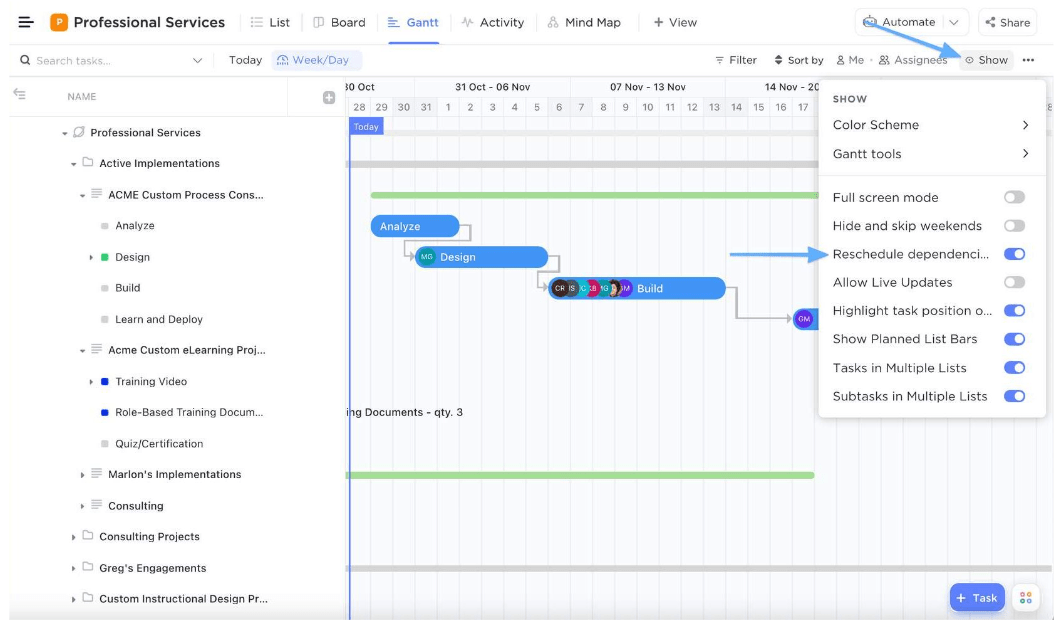
Free slack is not extra time to relax deadlines. If you use it up unnecessarily, you lose the natural buffer that shields your project from small disruptions. So, encourage teams to stick to planned dates unless there’s a clear need to use the slack.
Custom Views enable you to filter and highlight tasks by slack time or custom fields—so your team knows where time buffers exist and where they don’t. Use this to consciously protect free slack zones
💡 Pro Tip: The ClickUp Timeline View is ideal for monitoring workloads across people or teams. You can group tasks by assignee, department, or priority, and view their schedules side by side.
For instance, say a QA analyst finishes testing on Thursday, and the next deployment task begins next Monday. This view shows that three-day gap in their lane.
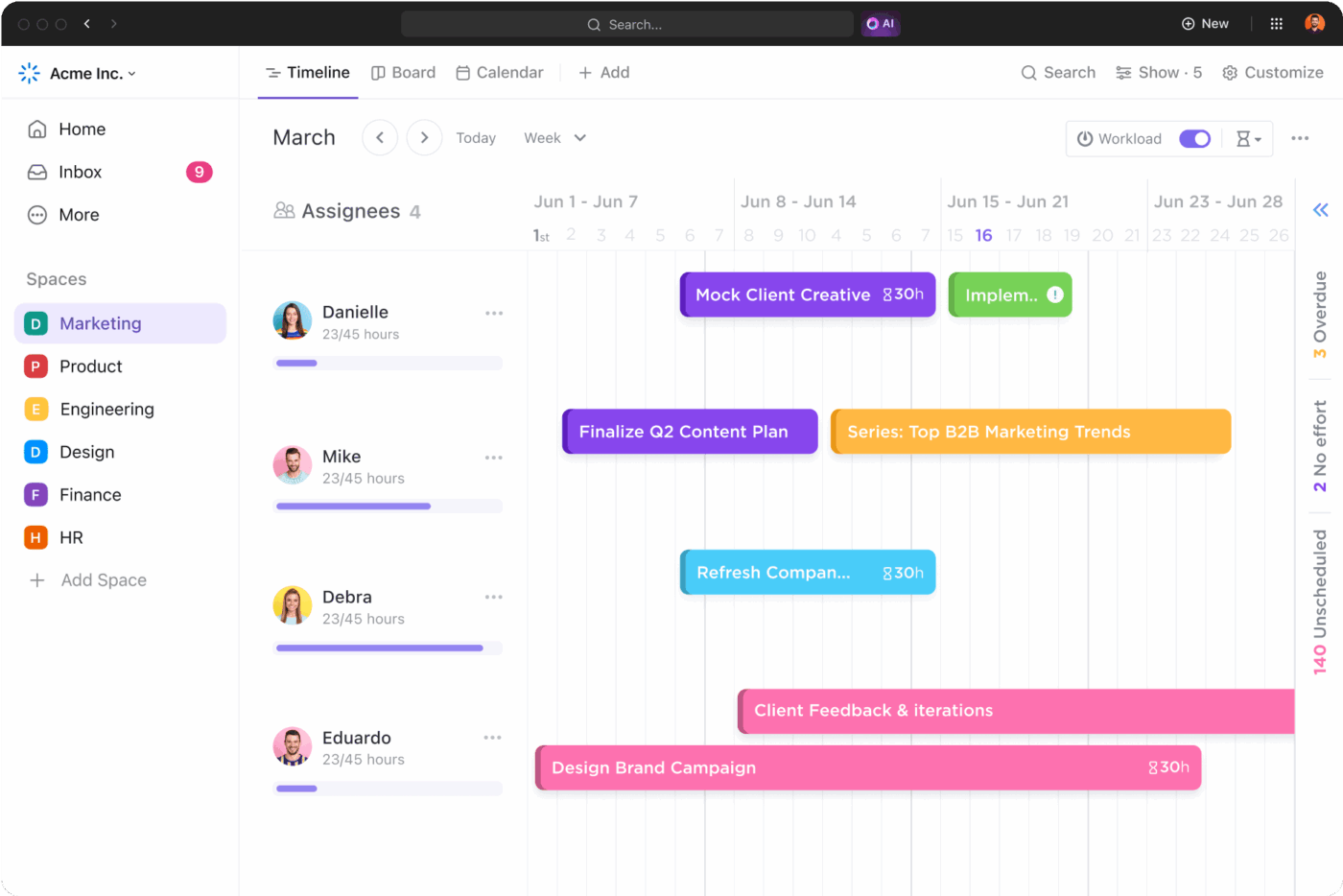
Free slack is dynamic; it changes whenever you adjust task durations, dependencies, or calendars. After each schedule update, review where free slack has increased, decreased, or disappeared to keep your risk picture current.
💡 Pro Tip: ClickUp’s Gantt charts update in real time, ensuring your visualization stays current. Any changes in task duration or sequence immediately reflect on slack indicators.
Make sure task owners know exactly how much slack they have. A developer who thinks they can “take two more days” when only one day of free slack exists could unintentionally delay testing or deployment.
Notifications let stakeholders know instantly when a dependent task changes—or when slack time shrinks.
💡 Pro Tip: Set up trigger-based rules in ClickUp Automations to automatically notify stakeholders of changes in project schedules.
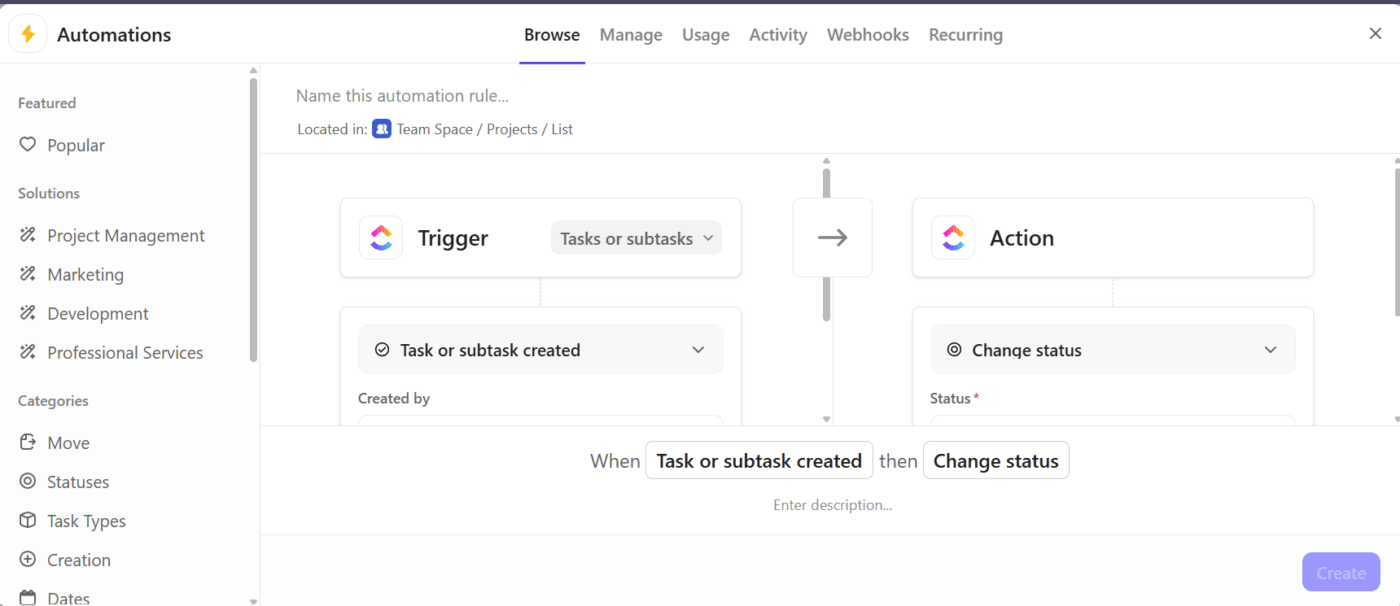
Traditionally, monitoring and acting on free slack meant constant manual checks. But with platforms like ClickUp, PMs can get real-time insights on where to protect slack, where to reassign, and how to communicate risks.
With ClickUp Brain, managing free slack becomes proactive instead of reactive. Instead of manually scanning Gantt charts, just let Brain surface at-risk activities, explain the impact, and even suggest resource reassignments.
It can also draft quick stakeholder updates when free slack tightens, so your team acts before delays cascade.

Here’s a quick prompt dictionary for you:
And if you want ready-made templates that can cut down the work for you, use the ClickUp Critical Pathway Analysis Template.
This project timeline template helps project managers monitor schedules, dependencies, and free slack at a glance. It organizes tasks by project phases, such as research, implementation, and review.
The timeline pane is represented as a horizontal bar plotted against calendar dates, with dependency lines connecting tasks that rely on one another. Additionally, tasks with red highlights indicate tightly stacked tasks or those with zero slack.
Here’s what Justin Kosmides, CEO, Vela Bikes, says about ClickUp’s Gantt charts:
Being a smaller team and having thousands of orders from around the world, we need to be ultra efficient and ClickUp Gantt charts allow us to track all of our production and logistics in one place, which made our production team two thirds more efficient.
Another great ready-to-use customizable structure is the ClickUp Gantt Timeline Template.
This Gantt chart project template helps teams plan, visualize, and manage tasks across time. Tasks are arranged sequentially in a color-coded format, making it easy to follow the project’s progression. Plus, dependency lines connect related tasks, ensuring the flow of work is well-defined.
Striped patterns on tasks indicate slack time, giving teams built-in flexibility.
For always-on oversight, ClickUp Autopilot Agents are your best bet. These tools monitor your workspace actively, acting when your project logic needs protection.
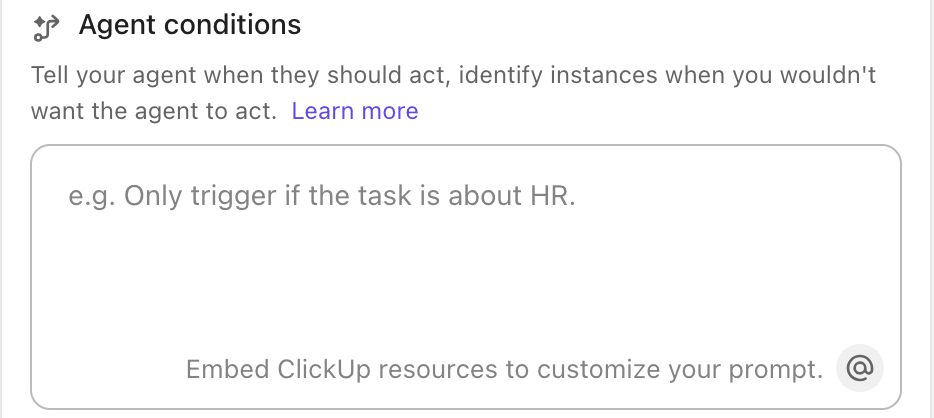
Say your design task is running two days behind and is about to consume all available slack. A prebuilt agent can alert your creative lead, suggest shifting a review meeting, and even reassign follow-up tasks.
Here’s an example setup:
ClickUp Brain powers these agents, so their decisions are based on your actual task dependencies, team capacity, and project setup.
📖 Also Read: Free Gantt Chart Software
Free float or free slack is a practical way to stay on top of project timelines, dependencies, and resource allocation. Tools like ClickUp help you understand exactly how much wiggle room your tasks have to save the project from last-minute panic.
ClickUp for Project Management is the everything app for work that combines project, knowledge, and chat in one place—all powered by AI that helps you work faster and smarter. It helps you stay ahead of delays, confusion, and missed handoffs.
With Gantt and Timeline views that visually map out dependencies and highlight slack, automations that flag issues, and context-rich AI assistance integrated through the platform, you get all the help you need to enhance your team’s productivity.
Sign up to ClickUp for free today! ✅
Free slack or free float in the Critical Path Method (CPM) enables project managers to identify areas of flexibility in the schedule for individual tasks. This allows them to reallocate resources or adjust timelines without impacting dependent tasks or the overall project finish date.
Yes, a task can have both free and total slack, but the values may differ. If a task isn’t on the critical path, it may have both positive free and total slack, but tasks on the critical path have zero slack.
When free slack is zero, it means that delaying the task would also delay the start of the next task. In CPM, this often indicates that the task is either on the critical path or is directly controlling the schedule of its successors. If you have a negative slack value, that means you don’t have any buffer time, and you’re overdue.
Many project management tools can automatically calculate and display free slack. ClickUp helps you schedule tasks and monitor free and total slack deadline dates, right from your Gantt charts and Timeline views. Slack time is visualized as a dashed bar, indicating the amount of flexibility other tasks have before they impact the next one or the overall project plan.
© 2025 ClickUp